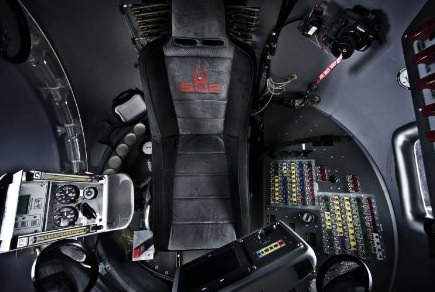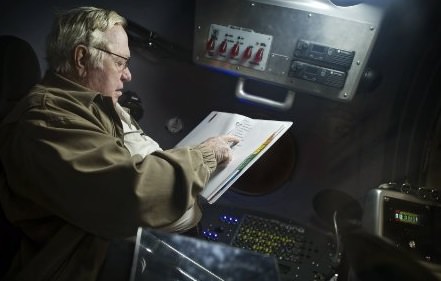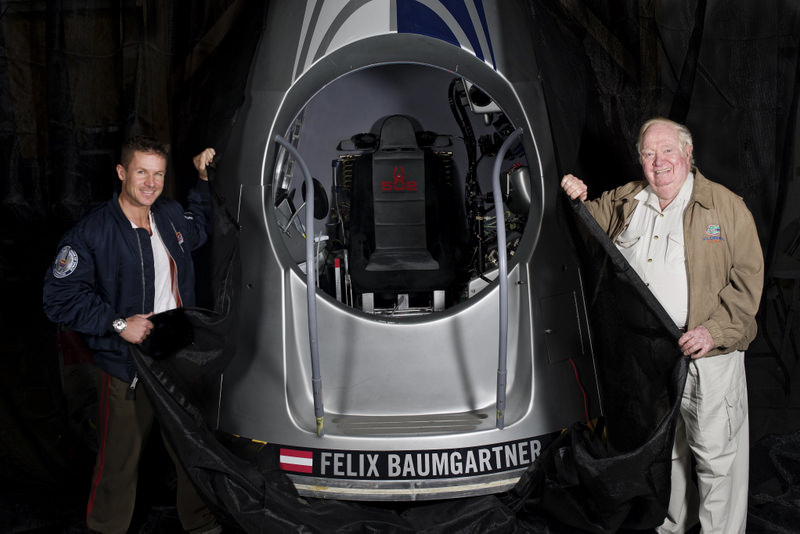[/caption]
Part science experiment, part publicity stunt, part life-long ambition, the Red Bull Stratos mission will feature skydiver Felix Baumgartner attempting to break the speed of sound with his body in a record-setting freefall from the edge of space. The team has been working for over 5 years to build the high-tech capsule that will bring Baumgartner to 36,500 meters (120,000 feet) above Earth, via a stratospheric balloon, and Red Bull Stratos has now released a few images of the capsule. The craft weighs 2,900 pounds fully loaded and it will act as Baumgartner’s life support system during his nearly three-hour ascent. Here’s the outside of the capsule, with Baumgarter standing by, along with the current record holder for such a jump, Joe Kittinger, who jumped from 31,333 meters (102,800 feet) in 1960.
Take a look inside the capsule:

The pressurized area inside the capsule has of less than 2 meters (6 feet) and contains the flight control panel with 89 different switches and various instrumentation, and a custom-made chair custom to fit Baumgartner and his space suit. It is molded from fiberglass and epoxy, while the door and windows are made of acrylic. The pressure sphere’s interior will be pressurized to 8 pounds per square inch (psi), the equivalent of 16,000 feet above sea level, to reduce the risk of decompression sickness during the ascent without requiring Felix to inflate his pressure suit.
The clear door will give Baumgartner the best view in the stratosphere, but it also puts just half an inch of acrylic between him and the edge of space.
A Chrome-Moly cage and an external foam-insulated shell surrounds the capsule, making it 3.3 meters high (11 feet) and 2.4 meters (8 feet) in diameter at its base.
According to Red Bull Stratos, the capsule will be suspended 45 meters (150 feet) below the balloon, and will protect Baumgartner from stratospheric temperatures reaching minus -55 C (-70 Fahrenheit), providing a pressurized environment during the ascent, with air to breathe so he can avoid decompression sickness. He will inflate his pressure suit only as he prepares to exit the capsule.

When Kittinger made his jump, he used a gondola instead of the sealed capsule that Baumgartner will use. Red Bull Stratos says that the additional altitude for this mission means that there are exponentially greater hazards from exposure to freezing temperatures, oxygen deprivation and low air pressure, and the capsule is designed to protect him from that.
The science team collaborated with aerospace engineers to overcome the challenges that the hostile environment of the stratosphere presents to the electronics, radio communications and camera systems vital to the capsule’s operation. They also wanted to build a vessel capable of capturing valuable scientific data as well, to help advance aerospace research. The capsule was designed and hand-constructed at Sage Cheshire Aerospace, Inc. in Lancaster, California.
Once the capsule has completed its ascent and Baumgartner has safely accomplished his mission, a remote triggering system will release the craft from the balloon. Tracked via a GPS system, a recovery parachute will bring the capsule slowly back to Earth, where the data can be extracted and evaluated.
The base of the capsule has a 5 cm (2-inch) thick aluminum honeycomb panel which protects the capsule from sharp objects during landing and provides a mounting for the balloon system control box and batteries. Attached to the base are the landing crush pads, made of a cell-paper honeycomb covered by a fiberglass/epoxy fairing. They are designed to handle as much as 8 Gs on impact. Taking more than 150 drop tests to develop, the crush pads can be used only once and must be replaced after every flight.
The capsule has been thoroughly tested, and the Red Bull Stratos team says they are ready to fly. An exact date for the jump has not been released, but sources say it will likely be in August or September 2012.
More info:
Red Bull Stratos website


Good luck.
In the pre-supertechnology horse and buggy days Joseph Kittinger on August 16, 1960, made the jump at 102,800 feet (31,300 m).
Can’t wait for this to happen.
I’m a bit curious as to why they needed to make a custom-shaped seat for Felix. Seems like it would just drive costs up, only for a little extra comfort during his 3 hour ascent? Maybe it’s a bigger issue than I think it is.
my understanding is that when he is all suited up he wont be capable of moving around very much. So by custom shaped they mean to accommodate the suit and to make it easy to get out the door. When Kittenger jumped he didn’t stand up because his suit (which was designed for pilots and therefore structurally oriented towards a sitting position) was so ungainly he couldn’t, he simply leaned forward until he fell out!
Joe was the first man to dare going up in a high altitude balloon. I’m to understand that he had to get off of the seat , which momentarily was stuck to the suit, and leave the platform and free fall with only his suit to protect him from the harsh temperatures during his subsonic decent. He was quoted as saying that he was approaching the speed of sound before he popped the first chute. Joe has paved the way for Felix to do his encapsulated stunt.
Bu the way, good luck, Felix.